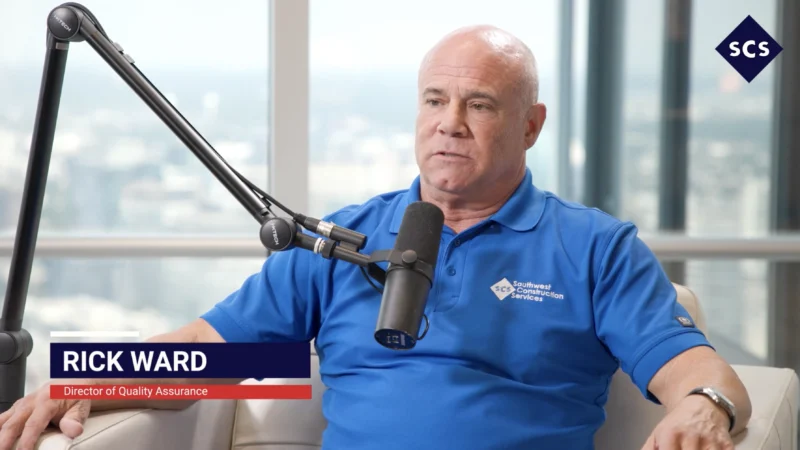12 Must-Follow AEC Social Media Influencers with Bryce Stuckenschneider
This podcast is the third of a three part series entitled “How to Stay Connected and Relevant in the Digital Age of Design” and is featured on MarketScale AEC.
The proliferation of social media has given rise to a new breed of cultural leader: the microinfluencer. Also known as just “influencers,” these social media masters are creating personal platforms that are not only curating the hottest trends, but setting trends of their own for consumers. The microinfluencer isn’t limited to B2C though, and not by longshot. B2B influencers have the potential to set decade-long standards for their industries, and represent the authentic voices within their communities. On this final podcast from the series How to Stay Connected and Relevant in the Digital Age of Design, Bryce Stuckenschneider and Daniel Litwin analyze 12 of the most engaging influencers in AEC, and how they’re impacting the industry, from interior design to commercial architecture.
“I think that great ideas can come from anywhere,” Stuckenschneider said. “And one of the incredible things about social media is I can pull inspiration from people who live in a remote corner of the world, people that I would’ve never had a chance to interact with.” This list of 12 is the end-all be-all of lists, nor is it definitive. What it does bring is an authentic list of influencers no matter their reach, from the editor-in-chief at Interior Design Magazine to smaller individuals with a few thousand followers. “I think there’s something to gain there; not only can you learn why it’s important to use social media as the tool to get those messages across, but then just deeper, I mean each influencer is bringing a fresh perspective to the table and whether it’s interior design, whether it’s commercial architecture, as an AEC professional, you could gain some tips for design, for construction or maybe even just the processes of how you go about collecting your data,” Litwin said.
Click here for the full article outlining each of the 12 influencers Stuckenschneider picked out, and give this podcast a listen for more insight on why each was chosen and how they’re impacting AEC.
HIGHLIGHTS FROM THE EPISODE
THE IMPORTANCE OF AN AEC INFLUENCER
Daniel Litwin: I think when you think of a social media influencer, I think most of the time the conversation is focused around a B2C perspective. So most social media influencers are sort of setting trends for consumers in what to buy, what’s cool, what to wear. You know, maybe it’s like what music you should be listening to, kind of consumer aspects.
But I think that being a social media influencer in the B2B space is just as important and honestly it could be even more beneficial because you’re helping set trends within an industry that might influence design, it might influence security measures, it might influence customer relations for the next decade. Who knows? I mean, we’re at that point where social media is having that kind of impact. So in your opinion, I mean, how important do you think being a social media influencer is in AEC, or I guess just how important is it to have [influencers]?
Bryce Stuckenschneider: Yeah. I think having some is great. I don’t know that everybody needs to be an influencer who gets influenced in a world full of influencers, but I think that great ideas can come from anywhere. And one of the incredible things about social media is I can pull inspiration from people who live in a remote corner of the world, people that I would never had a chance to interact with. And so that’s kind of the point of the article for MarketScale.com and this conversation today is I’m not giving you that list of, “Here are the top architects and designers in terms of follower account,” like you can go find that. In fact, I think in the footnotes of the article I’ve got about 12 different articles of, “Here are the different names. Why Instagram has become a vital tool? Ten architects you need to look out for. Ten must-follow architects.” I’m not saying those lists are wrong. This is a little bit different. Here, maybe some people you don’t follow. Here’s a cross section. Here are people who have a ton of followers and people who maybe have 1,000, 2,000 followers, but they’re sharing something that I think is worth is keeping an eye on and there’s a lot of diversity in it. There’s a lot of different things that you can watch and be inspired by and so we’re going to talk a little bit about each of them and we’ve broke them into categories because why not, bite-sized chunks. So that’s what we’re going to do today.
DL: All right, well, I think it’s time to dive into your list. What you mapped out here is even though it’s only 12 people, it’s a pretty comprehensive list here and very diverse. We’ve got people from interior design, furniture and industrial design, commercial architecture, and technology and design. Why did you choose these four as your main breakdown here? Was this just what you saw the most of or was there a deeper reason?
BS: Well, when you look at the type of content they share, it naturally falls into buckets like this. Everybody can share inspiration and anything can inspire anyway. Anyone in all four of these categories could walk by a koi pond and be like, “Okay, I’m inspired by this,” sit down and sketch it. And we’ll talk about that type of post. But in general, I was looking for things that were different. And so I started with a list of over a hundred. I kept whittling it down, narrowing it down, and then when I got to the final 12, I said, “Okay, what do these groups have in common?” And they naturally kind of gravitate towards these buckets.
INTERIOR DESIGN
DANA TOMIC HUGHES, YELLOWTRACE
DL: So let’s start with Yellowtrace. Tell me a bit about why you put Yellowtrace on here for influencer and interior design.
BS: Sure. So this is actually out of Australia and New Zealand, so totally around the world. So we talked about how social media allows us and gives us access to people who are not near us. This is a great one. This is kind of a lifestyle design resource for interior designers. They really fancy themselves as kind of the resource for creative and curious minds. And so maybe that’s in the interior design space. Maybe it’s not. Maybe it’s in other parts of design inspiration and creative that a lot of creative professionals follow.
Dana Tomic Hughes is a design-obsessed human, self-proclaimed. That’s what she is. And so she’s the publisher for Yellowtrace. And really while they’re based in Australia, they have influence around the world. And so I love a lot of the things that they share and sometimes it’s creative brainstorm sessions, sometimes it’s, “Hey, look at this one natural material that we’ve never used in an install before.” And one of the things I like most about this was the variety that we saw.
And also showing the daily grind too. If you follow, it’s, “Hey, here’s a session we had today. Here’s what we accomplish. Here’s what we set out to do.” And it’s very much not, “Here’s just a glamorous picture of the end work of what we did.” But there’s real work that goes in a great design. And that will be a trend throughout all of these and I mentioned authenticity before.
CINDY ALLEN, INTERIOR DESIGN MAGAZINE
BS: But that kind of gets me into the next one of Cindy Allen. So she’s the editor in chief Interior Design Magazine, probably one of the higher follower accounts on this list.
Interior Design Magazine has millions of followers, not surprising. But she herself has north of 15,000 and one of the things that I love that she does besides she shows the business side of running a magazine, so every month when the issue comes out, there’s a video of her unboxing. It’s something really simple like that where she’s taking pride in the work. That’s one of my favorite posts every month is like I could tell she gets excited to do it.
But another thing they do at Interior Design and that she’s a big part of is they have this hall of fame for interior designers and every year in December, they have a big hall of fame dinner and there’s really two, three, four, maybe five inductees every year. So it’s a very prestigious group of people, and on her feed talk about, they spent the entire year deciding who the inductees are going to be. She spends time with them in their homes interviewing them, understanding the highlights and hallmarks of their careers. And so her social media feed, specifically her Instagram, which is @thecindygram is a really cool glimpse into, “Here are some of the legends of the industry.” And so that’s one of the reasons that I included her on the list.
DL: That’s cool. Paying homage to the people that already set the trends and then in essence becoming a trend setter herself. It’s great to see the different ways people are using social media in the space for sure. And then what about a disruptor in interior design? You got Sarah Sherman Samuel in here.
SARAH SHERMAN SAMUEL
BS: Yeah, sure. So this one was a little bit because she, from the time I’ve been following her, is really more of a materials textiles influencers. She’s got a very southern California spirit about her in vibe. So we talked about Australia and New Zealand, now we’re talking about California and everything, every single post she has, you’re like, “Okay, I get it. She lives in California.” And so while that’s a very specific design style, she’s got roots in Grand Rapids, which is obviously one of the furniture capitals of the United States, really cool interior shots, but I love when I looked at an account like this. It was all about a pairing of materials and things I just hadn’t seen. I felt refreshed. Every time she posts something, I’m like, “Ah!” That inspires me. That makes me seek out some more that’s more refreshing than a coffee shop.
DL: It looks good, yeah.
BS: Absolutely. So that was certainly one. She does a really good job. She’s one of the few on this list that does an awesome job with stories. And so Instagram stories is a great way to tell sort of a daily log or a video log if you will of things that inspire you, projects you’re working on, authentic aspects of your life. And so she’s got a really, really robust list of stories. There’s always a categorized story. So if I didn’t watch it in the 24 hours after you posted it, she’s actually got them into little bite-sized chunks which is great as well. So that was another I looked down on this list is it’s not just the types of posts people are doing but how they’re using the platform to the flows of what it does.
DL: I agree. I mean just looking at her Instagram, you can tell she has a real eye for just crafting a good-looking post. The shots all are framed really well, everything looks really intentional, really polished and clean. And that’s really important if you’re trying to set a standard for I am influence on Instagram. I mean there’s sort of a code of conduct there almost. You know what I mean?
INDUSTRIAL DESIGN
BUZZISPACE
DL: So next we’re going to hop into furniture and industrial design. So let’s start with the trend setter you had here which is Buzzispace.
BS: Yeah. So this is I think the lone furniture brand on the list and what I love about them is they’re just fun, they’re just different. And so I’ll give you a couple of examples. If you’re not familiar with BuzziSpace, they make all sorts of stuff, but acoustics are kind of at the core of what they do. So they’re like, “We’re going to tables, chairs, screens, lights, everything we have has an acoustic nature to it.” And they really try to be different and that’s one of the things I appreciate and you see that on their social media. So a couple of examples.
One of them in their showroom in Chicago, they have a permanent showroom there, is they have this room that you walk into and it’s a room without acoustics and it’s just a room with a wooden floor and dry wall and there’s really nothing to it. And there’s the identical room next door and they introduce their products into it. And so it’s a chance for you to walk from the echo chamber of a standard non-acoustically designed room into a room that’s just got one or two of their products. It’s not clad floor to ceiling or like the studio we’re in right now that has acoustic material all over the walls. It’s just a couple of tastes where you place pieces and you can hear the difference and they actually show that on their Instagram, which I think is really cool.
DL: Yeah. Well, it’s beautiful and practical at the same time is kind of what I’m getting from their content. All right, let’s jump into the thought leader here which is design bunker. What drew you to their space? I mean their Instagram really catches my eye, but a lot of the really minimal pictures they post on there that are just… they all just look so clean, polished, almost like it was made in Cinema 4D or whatever.
DESIGN BUNKER
BS: And so anyone who’s in the AEC industry, specifically designers, probably have heard of the account Design Milk. It’s one of like the most followed design social media accounts across here.
DL: Got Design Milk?
BS: Yeah, exactly. So Design Bunker to me is kind of like the under the radar version of that. They’re just sharing things that are different inspiration. They’re kind of a curator of content. So all they do is find great stuff that other people are creating and share it on their platform. It’s worked. I mean they’ve got over 400,000 followers just kind of taste making and curating content from others. And if you follow Design Milk, and millions of people do, I think that you’ll enjoy following Design Bunker.
KEM STUDIO
DL: So tell me a bit about KEM Studio here, a disruptor in furniture and industrial design.
BS: Yeah. Sure. So this is a studio out of Kansas City and they are both an architecture and an industrial design firm. And so they’re designing products, they’re designing apartment buildings, they’re designing high-end playgrounds, they design skateboards, they design a bench that looks like a skateboard. They actually work recently on an incredibly high-quality speaker system. So kind of across the gamut and stuff. They’re designing award-winning buildings on one side and award-winning speakers on the other side. And what’s kind of cool about their approach, and if you follow them, and is they’re very research based. They really love to deep dive into the problem they’re solving for their clients.
And one of the things that they do, and this is one of those accounts that I would classify as they didn’t make the list because have tens of thousands of followers, they have a modest following, but I think the type of content they’re sharing is worth looking at. Their approach is certainly, we want to share a variety of the best of the best things that we see do and they’re inspired by.
COMMERCIAL ARCHITECTURE
ALEXANDER GORLIN ARCHITECTS & LEE MINDEL
DL: So next chunk that you mapped out in your article is influencers in commercial architecture. So let’s hear about the ones you chose for this sect.
BS: Sure. So I think that it’s really easy on Instagram to show images of beautiful interiors. I think it’s a little bit harder to show beautiful exteriors and the amount of detail that went into it. And so certainly that’s one of the reasons that Alexander Gorlin Architects and Lee Mindel, both New York based architecture firms and architects themselves made the list, really
inspiring exteriors and give you that essence of what it’s like to be in the city. I mean they are in the city, right? And so it was nice to have them on the list for myself because I haven’t spent a lot of time in New York, but I know that about 40 percent of the design work in America is specified out of New York City. And so even though I’m not there, it’s the hub of what’s happening. And so I think it’s important for, if you’re creating a watch list or ways to kind of inspire yourself as the kids say stay awoke, I think that it’s important to have a couple New Yorker architects on the list.
BOB BORSON
BS: So the next name on this list is a Dallas-based architect is Bob Borson and I like this account, and Bob, even though I never met Bob, because Bob from my estimation is really trying to inspire the next generation. He actually started a blog around his architecture work. He was once named Young Architect of the Year, but he created a website, lifeofanarchitect.com. And it’s tips, tricks, it’s the struggle, it’s taking the idea of influencing community beyond a square image on Instagram and making it very real. And so that was one of the reasons Bob made the list, also has a very significant following as well. But that’s the kind of the commercial architecture side.
TECHNOLOGY IN DESIGN
HUTCH, HOUZZ & HOMEPOLISH
BS: And this last category, I mentioned before is design technology. How do modern technological advancements, startups, tech companies influence us? Sometimes good, sometimes bad, sometimes somewhere in the middle and that’s kind of why these next three brands made the list.
DL: Well, it’s important to not get caught up too with a lot of these new fancy technologies to not get too caught up in the prettiness of it or that is, “Oh, it’s a great new toy.” But if you’re trying to implement them into the design world, everything that we’ve seen so far I think has been pushing towards intentionality, authenticity. And so if you’re just slapping things on there because they’re new and cool, you might be missing out on that and at the end of the day actually harming your design, making it less functional or making it less appealing.
BS: So, the idea behind all three of these and to recap, we’re talking about Hutch, Houzz, and Homepolish. The idea is, “How do we make design accessible to the masses?” And so if the internet allows me follow an interior designer or an influencer halfway around the world, why can’t it help me tap into the talent of an interior designer who could be just down the street for me?
And so, the idea that it’s a new way to design your home, right? And most of them would boast that they are an end-to-end solution, you know, “We’re kind of your one-stop shop. You can, in a lot of cases, send us a picture of your existing room. We can take it from there and deliver a design back to you, not just the design but actually curated products that are going to make this space work better for you.” And so each of them are using technology in an interesting way.
DL: So I think what we see there is again this authenticity, the humanity behind the technology. Not only are we trying to find more human-focused and human-centered designs in the spaces, but the way that we’re contacting these people, the way that we are influencing AEC professionals is through technology. And so he’s saying we got to make sure that it stays human-centered and authentic.
If you follow Homepolish on Instagram, you find that they’ve got no shortage of beautiful interiors that they helped design for their clients, but one of the things that he said, you know, how do you make it personal, how do you tug on the heartstrings is they really inspire their followers to imagine themselves in these spaces. Imagine a place like this in your home and then they engage in dialogue in the comment section, which is another thing that we talked about. It’s not just about posting the picture, but how you use the entirety of the platform, Homepolish does that in a really, really great way.
MARK COXON AND THE TOPICAL SOCIAL MEDIA CONTENT
DL: So, this is not someone that’s on your list but provides kind of a different point of view in technology and design, more of what I was talking about earlier of adapting the actual physical technology in the designs to be human centered, to be intentional. His name is Mark Coxon from Barco and he does provide sort of a different kind of tip but one that still applicable for AEC professionals.
BS: Yeah. I think this one is great too because this is the type of content I think that create social media influencers share. They say, “Hey, here’s a real practical thing,” and he’s going to talk about video walls. And he’s saying, “Here’s just a very simple tip. This could be a great post. Is it visually stimulating so does it make a ton of sense for Instagram? Maybe not. Maybe it’s a great Twitter post. Maybe it’s just a video, an Instagram story or something to share like that.”
Mark Coxon: Hello, Mark Coxon, the AV Phenom, with a quick video wall building tip. Be odd. If you are using an even number of columns and an even number of rose when you build a video wall, you are bound to have crosshairs in the middle of your content. An even number of columns means you will have a vertical seam through your content and an even number of rose means that you’ll also have a horizontal seam through the content. However, if you use an odd number of each, your center screen will be free from those seam interruptions and the rest of the vessels will fade in the viewer’s peripheral.
BS: And on the face of it, it’s a really simple tip, but now you think about it. I’ve actually had to work on a couple of video wall installations and I’ve never thought of that. I never thought about the number of panels I had and the impact it was going to have on the look down the road. But now that I hear him, like wow, that’s a really simple nugget, tidbit, and that’s the type of content and engage audience really wants to follow.









